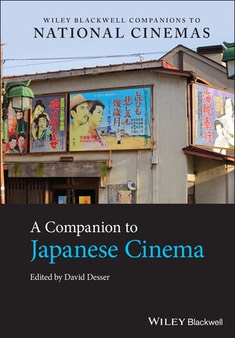
It’s taken a while to announce this publication, but it took even longer for it to appear. Wiley-Blackwell’s A Companion to Japanese Cinema, edited by David Desser, was finally published earlier this year, with a piece by me on the relation between cinema and television in the first decade after the start of public broadcasting in Japan. Editing these kind of general handbooks is not an easy task, so I salute David for not only inviting me to participate, but for also managing thirty people writing on very different topics. The list of contributors is like a who’s who of Japanese film studies.
My chapter is a continuation of a number of articles I have written on the early years of television in Japan, particularly my piece "From Film to Television: Early Theories of Television in Japan” in Marc Steinberg and Alex Zahlten’s Media Theory in Japan. If that focused on early theorizations of television in Japan, arguing that efforts to distinguish television often forgot, while also reproduced, some of the claims made about cinema in its first decades, this contribution considers how film was actually a key means by which television was constructed. Pushing back against the often-told history of the film industry’s antagonism against television once broadcasting began in 1953, I show how the industry was not only actively involved in TV, even helping found some of the key networks, but was only antagonistic to the degree television became too much like cinema. The film industry was thus accepting TV as long as it was not a threat, and thus was deeply involved in attempting to form TV as difference. I continue my previous work on TV theory by also arguing that theorists such as Iijima Tadashi, Sasaki Kiichi, and Okada Susumu similarly tried to conceptually police the border between film and television, especially when it came to the practice of using film to make TV programs (a practice called terebi eiga at the time). Distancing myself from claims that the appearance of television led to the conceptualization of “eizo” as modern technological moving images transcending media specificity, I point to Okada’s theorization of TV as “half-image” (han-eizo) as one example of how eizo was repeatedly theorized through difference and distinction. I conclude by speculating about how these attempts to invent television were also efforts to create a new synthetic media which would, at the same time, enable new forms of cinema.
Unfortunately, it took about five years from when I wrote the article to when the Companion came out, so it does not mention research that appeared in the meantime, such as Kitaura Hiroyuki’s Terebi seichoki no Nihon eiga, that is engaged with similar issues. I hope my piece can be read alongside such works.
Here is the bibliographic information. It is currently too expensive for most people to buy, so look for it in your local library.
- Aaron Gerow, “ Inventing Television through Film: Japanese Cinema and TV, 1953–1963,” A Companion to Japanese Cinema, ed. David Desser (Hoboken: Wiley-Blackwell, 2022), pp. 510–528. ISBN 9781118955321. Get it at Powells.

